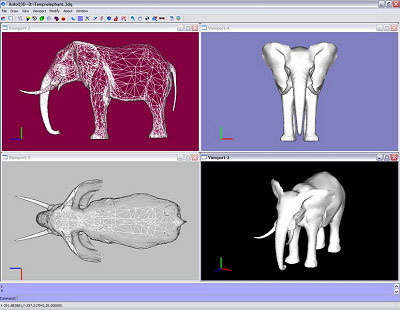 Before AutoCAD there were other applications, most of them on UNIX; one of the few that still remain is Intergraph, from which Microstation came out, although this was not on UNIX but on was a perative system capable of doing CAD in the mid 70’s. However, AutoCAD arrived in the eighties to win the mandate, now that it is 25 years old, let’s take a look at at least six lessons that have made it the leader … as are Windows on the desktop, ArcGIS in geospace, Google on the web.
Before AutoCAD there were other applications, most of them on UNIX; one of the few that still remain is Intergraph, from which Microstation came out, although this was not on UNIX but on was a perative system capable of doing CAD in the mid 70’s. However, AutoCAD arrived in the eighties to win the mandate, now that it is 25 years old, let’s take a look at at least six lessons that have made it the leader … as are Windows on the desktop, ArcGIS in geospace, Google on the web.
| FIRST LESSON | Don’t work with the good guys, work with the popular ones, AutoCAD decides to evolve at the pace of DOS |
| 1982- AutoCAD 1.0 | Presented at the COMDEX Trade Show |
| 1983- AutoCAD 1.4 | From this version until R13 ran on DOS, came on 2 5-1/4″ disks, cost $1,400 but an IBM with 64k RAM cost $5,000. The competition was VersaCAD. |
| 1984- AutoCAD 1.6 | Autolisp is introduced |
| 1985- AutoCAD 2.1 | First 3D capabilities appear New commands; Mirror, Osnap |
| 1986- AutoCAD 2.4 | This version made it very popular, and no wonder, the new commands sound familiar: Divide, Explode, Extend, Measure, Offset, Rotate, Scale, Stretch, Trim. |
| 1987- AutoCAD 2.6 | Improved printing and 3D. AutoDesk makes the first alliances with the applications that became SoftDesk (now Civil3D). The competition were DataCAD, DrawBase and ArchiCAD |
| SECOND LESSON | If one competes and is better, buy it. AutoCAD works closely with SoftDesk for Civil Engineering |
| 1988- AutoCAD R9 | Many called it AutoCAD 3, the 3D faces appear. The competition: MiniCAD and Architron (Mac) |
| 1989- AutoCAD R10 | AutoCAD launches its first Mac version, fatal by the way. AutoCAD bets on fame, had 290,000 users and buys GenericCAD to have 850,000 users; in this way AutoCAD launches a campaign saying “we have more than 1 million users” |
| 1991- AutoCAD R11 | AutoCAD for PC and Mac, paper space and layout concept appeared. Improved 3D with ACIS, but exra was paid. Icons are introduced, in appearance of buttons, but always in DOS |
| 1992- AutoCAD R12 | External references (xref) are introduced, icons are increased. Competition: Microstation, although it was still an Intergraph product |
| 1993- AutoCAD R13 | In DOS and Windows 3.1 versions, 3D ACIS Modeller integrated, Stable versions for UNIX and Mac disappear. |
| LESSON THREE | AutoCAD dissociates itself from UNIX / Mac and decides to absorb Softdesk |
| 1994- AutoCAD R13c42b | For Windows 95 and DOS, it happens the bad year because it does not run well on Macs, which that year introduce the Powermacintosh. Autodesk decides not to release Mac versions until the year 2000, but ArhciCAD, PowerZ do. In the meantime AutoDesk decides to buy AutoArchitect and Softdesk which ran on an AutoCAD clone, from here the Architecture and Civil lines come out. |
| 1997- AutoCAD R14 | For Windows NT and 95, the same previous version, now in red color. Visio starts selling its program with an AutoCAD clone. DOS versions disappear. This year appears the first “Light” version called AutoCAD LT for $500 to compete with the small ones, DataCAD and MiniCAD, a full version cost $4000 |
| LESSON FOUR | If competitors sell cheap, offer a Light version. AutoCAD releases LT versions to compete on price |
| 1999- AutoCAD 2000 (R15) | For windows 95,NT,2000 AutoCAD makes paperspace friendly with the introduction of multiple layouts, and improves productivity with the use of the right button, looking for the user to stop using the keyboard… although there is no turning back, the previous versions cannot read a dwg version 2000. AutoCAD 200LT, without 3D or Autolisp, is again cloned (Architectural Ad-on) by GenericCAD, previously bought by AutoDesk |
| 2000- AutoCAD 2000i (R15.1) | AutoDesk looks for a profit with the Internet I, nobody knew what for. That same year AutoCAD 2000i light is released to compete with IntelliCAD which was free. |
| 2001- AutoCAD 2002 (R15.6) | Few improvements, only the drag&drop and saving of groups of layers. Online help functions were integrated, although nobody knew how to use them. AutoCAD 2002i ($135) to compete with IntelliCAD. |
| FIFTH LESSON | If they don’t buy, wring their necks. AutoCAD eliminates support for previous versions (did it with R14 and 2000) |
| 2003- AutoCAD 2004 (R16) | Express tools are integrated (before they were in Softdesk), the properties table is improved with a friendlier interface and the DWF format appears. |
| 2004- AutoCAD 2005 (R16.1) | CADstantard appears, dwg becomes less heavy. Many commands are moved from the command line to windows and layout handling is further improved. |
| 2005- AutoCAD 2006 (R16.2) | Dynamic blocks and tables appear. Improves (supposedly) the tediousness of dimensioning and the handling of layers without popup window. |
| SIXTH LESSON | Jeez, let’s just make it up. AutoCAD, aware of its technical competence, seeks to improve the aesthetics. |
| 2006- AutoCAD 2007 (R17) | 3D visualization takes on a new face after years of maintaining a bizarre rendering, this implies improving the textures and some of the interface. |
| 2007- AutoCAD 2008 (R17.1) | Improved integration with other “non-CAD” programs, more freshness in what was always ugly (dimensioning and printing) |
Although AutoDesk competes in the AEC lines (Architecture, Engineering and Construction) in which in 25 years it reached the leadership with its drafting table called AutoCAD, now it also competes in Geospatial, Manufacturing and Multimedia…
We will see what will be in the next 25 years.


